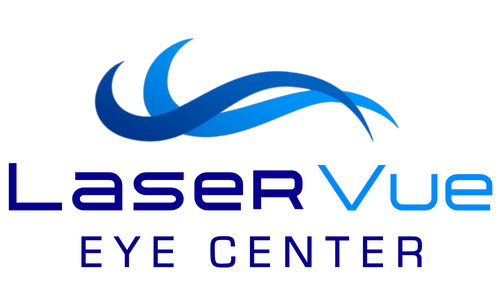Posted by: LaserVue LASIK & Cataract Center in Eye Health,Vision Correction Questions

On average, people in the U.S. spend approximately seven hours a day staring at various computer screens. In this digital age, the use of smartphones, laptops, kindles, Ipads, and wristwatches, is higher than ever before. While this is a major and widely agreeable development, the ease of consuming digital information means some people may actually spend more time looking at a screen than anything else throughout an average day.
Many people are beginning to wonder if the amount of time they spend in front of their digital devices could be having negative effects on their vision. One of the most common concerns we hear from patients is about the effects of blue light exposure from digital screens. Is blue light harmful to your eyes? Should you be wearing blue light glasses? Can blue light affect my vision?
In this guide, we answer some of your most common questions about blue light, its potential effects on your eyes, and the most effective ways to prevent digital eye strain.
What is Blue Light?
Digital screens emit three colors of light – red, green, and blue. These three primary colors are a result of the wavelength of the light ray and the amount of energy it contains. So blue light rays have short wavelengths and produce higher amounts of energy.
But blue light is not unique to electronic devices – it’s everywhere. People have been exposed to blue light every day since the dawn of man. Light rays from the sun are mostly made up of blue light. Sitting next to a window on a sunny day exposes people to nearly a thousand times more blue light than a digital screen ever could.
How Does Blue Light Affect Your Eyes?
To some degree, the eye’s cornea and lens are able to block harmful light like UV rays from reaching the retina. Meanwhile, virtually 100% percent of the blue light that passes through our eyes reaches our retinas. Thankfully, the amount of blue light from electronic devices is not harmful to any part of our eye, including the retina.
However, the way our eyes perceive this light is like visual noise or static that is always out of focus. Blue light travels as smaller, shorter waves, meaning it is more scattered than other colors in the visible light spectrum. When we spend hours at a time exposing our eyes to this visual noise, our eyes can become strained and tired. This is most commonly known as digital eye strain or computer vision syndrome.
What Is Digital Eye Strain?
Digital eye strain, also known as “computer vision syndrome,” is a term used to describe a range of symptoms or eye discomfort resulting from prolonged exposure to digital screens.
Focusing on things close up, naturally puts additional strain on our eyes. Add to that, the contrast and glares of a computer screen, our eyes are hard at work focusing and contracting, which causes discomfort after a while. Plus, when we look at these devices for long periods of time we blink much slower and less often, which leads to irritation.
Digital Eye Strain Symptoms
- Headaches
- Dryness of the eyes
- Shoulder and neck pain
- Watery eyes
- Blurred vision
- Itchy eyes
- Difficulty concentrating
- Difficulty in keeping eyes open
- High sensitivity to light
- General fatigue
Do Blue Light Glasses Help with Digital Eye Strain?
While blue light filter glasses can help block blue light from reaching your retinas, you are still likely to experience eye discomfort after being in front of a screen even while wearing blue light glasses. Prolonged computer use is associated with decreased blinking rates, which in turn dries out the eyes. Blinking is very important for keeping the eyes lubricated. Also, focusing up close for long periods of time can stress out our accommodative focusing system. If you have a muscle imbalance or accommodative insufficiency, you may feel eye strain when working on a computer for long periods of time.
Blue light glasses may help reduce some glare and visual noise from excessive blue light, but ultimately they do not address other causes of digital eye strain. If you are working late on a computer, blue light filter glasses may help maintain your circadian rhythm. Blue light is shown to decrease melatonin production, the hormone that makes you sleepy. Wearing these glasses late at night may help you sleep better.
How to Prevent Digital Eye Strain
While blue light glasses may not do much to prevent digital eye strain, here are a few things you can do to prevent it.
Follow the 20-20-20 Rule
For every 20 minutes of screentime, look at something 20 feet away for 20 seconds. The aim of this exercise is to relax your eyes by giving them a quick break. This also helps your body return to blinking at a more healthy rate.
Sit at Arm’s Length from Computer Screens
Sitting at about 20 inches from your computer screen imposes less pressure on your vision. If you sit too close to computer screens, it can increase your chances of experiencing eye strain.
Don’t Forget to Blink
We often forget to blink when staring at screens. Reduced blinking rates lead to increased evaporation of the tear film resulting in burning, redness, eye fatigue, or blurry vision. This is the leading cause of dry eye.
Wear Anti-Reflective Glasses
Glares and reflections from computer screens are some of the major issues that contribute to digital eye strain. By wearing anti-reflective glasses, the amount of light reflected from computer screens back on your eyes is reduced. You can also use anti-glare screen shields on your computer monitor.
Keep Your Eye Prescription Up-To-Date
Refractive errors such as nearsightedness (Myopia), farsightedness (Hyperopia), and Astigmatism can be corrected using appropriate prescription eyeglasses or contact lenses. Having an uncorrected vision problem, or eyeglasses that are out of date means your eyes are already working overtime to try and focus correctly. Keeping your corrective eyewear prescription up-to-date will greatly reduce the strain on your eyes.
Contact LaserVue Eye Center to Schedule an Eye Exam
So, while many of us experience eye irritation after a long day staring at one digital screen to the next, this discomfort is not directly caused by blue light itself, but rather digital eye strain. Digital eye strain can be incredibly uncomfortable, but thankful it can be managed.
Any persistent eye irritation or discomfort should be reported to your eye doctor imminently. If you are experiencing any symptoms of digital eye strain, contact the LaserVue Eye Center team and schedule an eye exam online today.

